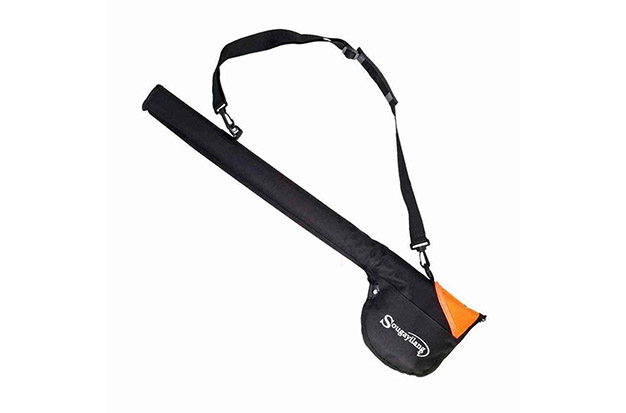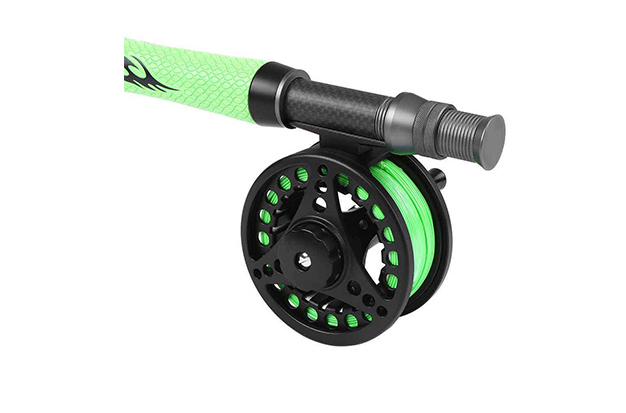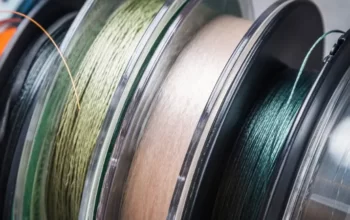As enjoyable as it is, fly fishing can also be difficult. The fundamentals of fly rod casting are actually quite simple to understand, but it takes a lot of practice to become an expert. Begin by adjusting your line so that it is properly set up to enable a good cast. After that, practice using the overhead cast. Once you’ve mastered the fundamentals, you can try using a roll cast to approach fish stealthily and in harder-to-reach areas!
Table of Contents
The Basics Of Casting A Fly Rod
Newcomers may find using a fly fishing rod intimidating at first, but with some practice, you can become skilled at using one. A fly rod is different from a conventional fishing rod in that it uses a heavy line to transport the incredibly light fly to its intended location. Making sure the fly rod is flexible and bends as you swing it is important to keep in mind when casting. This bending is essential because it contributes to the development of the force required to propel the line when you cast.
How To Cast A Fly Rod – 7 Steps
Fly Fishing Gear
Make sure your outfit is balanced before you begin your fly cast. Here are some resources to help you make sure you get the right equipment.
To cast a fly effectively, the weights of the reel, line, and rod must all be balanced. Your life will become much simpler as you get into this if you start with a balanced outfit.
Where To Practice Casting?
The best place to practice casting is on the water, so if you can find a nice, calm stream or lake nearby, head there.
Even if all you have is a grassy yard, you can still practice there. As a substitute for the fly, you can tie a small piece of yarn to the end of your leader. The yarn will somewhat adhere to the grass and aid in loading the rod.
For fly fishing, there are a few basic knots you should learn, but the yarn knot is all you really need to know to get the job done.
How To Hold The Fly Rod?
There are many ways to hold a fly rod, but ultimately it comes down to what is most comfortable for you. Thumb on top of cork is the most typical grib for casts of average length.
In the video below, Pete stresses the importance of using a relaxed grip and not gripping the rod too firmly, regardless of the grip you decide to use.
How To Hold The Line?
In order to minimize distractions when learning to cast a fly rod, I advise starting with a very small amount of line (20′ range).
Put your index finger on the cork of the handle if you are right-handed and pinch the line there. No line will come off while casting thanks to this.
You’ll eventually be stripping out line, double hauling, and doing all sorts of extra work, but we don’t need to consider that right now.
Simply remove about 20 feet of line and begin practicing.
How To Pickup And Load The Rod?
Making sure your line is straight out in front of you with little to no slack or bends on the water is one of the most crucial things to keep in mind as you begin your back cast.
Your cast will be more effective if you have less slack (bends and squiglies) when your line is in the water.
The most crucial aspect of picking up the rod is using a smooth acceleration. The energy will not be effectively transferred to load the rod with the herky jerky pickup.
In episode 233, the legendary casting coach Ed Jaworowski discussed how to accelerate properly.
One of the best podcast episodes on fly casting will probably be Episode 233.
Essentially, loading the rod involves transferring energy from the pickup into the back cast. The pickup of the backcast can be compared to using a paintbrush as an analogy. Consider dipping a brush in some paint and then dusting it off. Pull it out without dripping now, then exhale backward until you reach the pause. Be careful not to lose any paint as you try to throw that paintbrush.
Note: Your back cast and forward cast should be a straight line. The lines should be on the same plane and facing 180 degrees away from one another on the back side in order to efficiently transfer energy. forward cast.
How To Stop The Rod?
When you reach the point where you start to make a backward cast after picking up the rod and line with a smooth excelleration, you must stop (pause) the rod.
This is the hour of two prime (10 and two). However, in many circumstances it might be more like stopping at twelve. (Consider the hands on an old clock.
The third point in this guide discusses stopping and pausing the rod.
You’ll hear a snap on the forward cast if you don’t pause for a second and wait for the line to load up. Your leader and fly are being snapped, respectively.
When you backcast, if you take too long, your line will drop behind you and possibly hit the ground. A half second can make all the difference when fly casting because timing is everything.
You can then shift that energy to the forward cast after your line has loaded on the back cast with your pause.
Note: When you first start out, it’s a good idea to check your backcast to make sure the line is loading up correctly. When the line is straight behind you, you’ll know it is. (So, take time and look back at your cast to see if it’s loading straight behind you)l
The Forward Cast
You can now make a forward cast after that brief pause and rod loading. Bring the line forward 180 degrees from the backcast at eye level when you cast it forward.
Around ten o’clock, stop moving forward and shoot the line out. Don’t be afraid to really shoot the line out and exaggerate the motion if necessary early on. Drop your rod tip to the water to complete the cast once the line has shot out in front of you.
As soon as your line touches the water, you can start fishing and follow your fly.

Fly Fishing – 5 Tips To Improve Your Fly Casting
Similar to how it takes time, practice, and some understanding of the theory behind it all to become a skilled musician, becoming a good fly caster is similar. Here are 5 quick tips to help you become a better fly fisher and fly caster.
- Slow down.
Casting a fly line is a perfect example of the saying “less is more” in action. High line speed has developed into a myth that fly rod marketers spread and that ignorant anglers repeat. Most casters thrash a fly rod far too quickly; slow down and focus on proper form. Speed won’t get you where you need to go; good form and sound technique will. Your accuracy will also increase if you slow down. Use your ears to check this out. That swooshing sound your fly rod is making as it cuts through the air is a sure sign your tempo is too high, slow down, pause just a little longer and see if you can cast silently - Use less power.
Be smooth, like a fine whisky. Similar to my earlier point, but very different. Most casters overpower the rod, which is a significant cause of tailing loops. Maintaining an aerial fly line requires surprisingly little power. Try this easy exercise: Remove the last 15 to 20 feet of fly line, tuck your line hand into your pocket, and refrain from hauling. Casting attractive loops with the least amount of power should be your main focus. Take out a little power now, and then a little more. To draw more power, keep pressing the button. You’ll be surprised at how little work it takes to form a good loop; keep doing this until the line falls down around your ears (it won’t, not on your first tries). - Get comfortable changing your casting arc and stroke length.
The majority of us are self-taught flycasters who at some point read the same book. “Or something like that, fly casting happens between ten and two. Clock faces are for telling time, not for fly casting, as Lefty has pointed out. A shorter casting stroke and a narrower casting arc are needed when casting a short line as opposed to a long line. There should be practically infinite combinations of these. Long stroke, long line. Short stroke / line. For a thorough explanation, watch the video down below. Excerpt from “Casts that Catch Fish” - Tracking.
Tracking is the movement of the tip of your fly rod. Good single handed casting necessitates that the rod tip move in a relatively straight line in both the vertical and horizontal planes, unless you are spey casting, which requires the rod tip to move in three dimensions. Your line should be directly behind you on the back cast and directly in front of you on the forward cast, 180 degrees apart. The majority of fly-casters either throw their backcast out to the side or hook the fly rod around their back and toward the opposite shoulder.
Try this: Make a few practice casts, and on one of them, let it drop and lay out on the ground behind you. I can almost guarantee that your fly line will be running out behind you at an angle rather than directly behind you unless you’ve taken a few lessons and really focused on tracking.
The fix: Targets. Choose two targets: one far away in front of you, and one behind you. a tree, a marker, and a fencepost. Once you are lined up with your front and back targets, stand directly between those two targets. For both your forecast and your backcast, practice casting your line at the front target first. - The most crucial component.
Good fly casters are simple to spot because they have practiced. Spend some time throwing a line in the backyard or a park; even better, bring a friend so you can practice together. Yes, you’ll hear a few smartass comments from bystanders. If you hear anything original, please share it with me. All successful athletes train. It’s too late come game day, and there aren’t many things more annoying than duffing cast after cast.
Practice your fly casting with a short line, take your time, use less force, slow down, and perfect your tracking, and you’ll notice a significant improvement in your loops.
Conclusion
Timing and fluid motion are key components of the fly cast. Only through practice and patience will you master this. Keep in mind to start and pick up your backcast with a smooth, constant acceleration.
To help load the rod, maintain a soft grip but squeeze it when you stop. Redirect your energy back into your forward cast at this point, stopping when your line is at or just above eye level and you are at or about 10 o’clock.
Don’t be afraid to give your cast some heft. One of the great thing you have going for you is that most of the gear on the market




